Financial Statement Analysis of Gillette Ltd
VerifiedAdded on 2023/01/13
|12
|2863
|33
AI Summary
This report presents a financial analysis of Gillette Ltd using ratio analysis to assess profitability, liquidity, and leverage position. It also discusses the benefits and limitations of ratio analysis in decision making within the tourism industry.
Contribute Materials
Your contribution can guide someone’s learning journey. Share your
documents today.
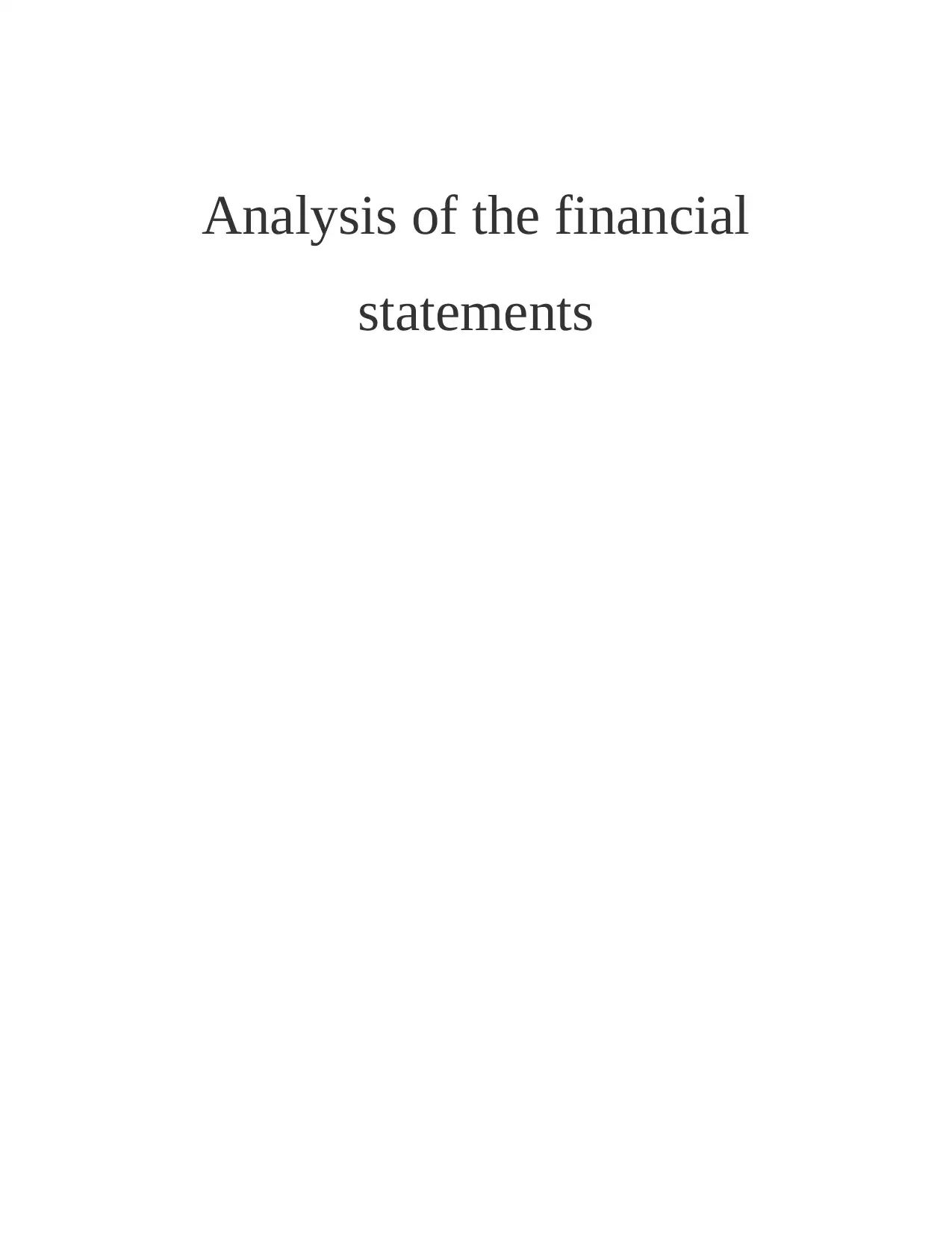
Analysis of the financial
statements
statements
Secure Best Marks with AI Grader
Need help grading? Try our AI Grader for instant feedback on your assignments.
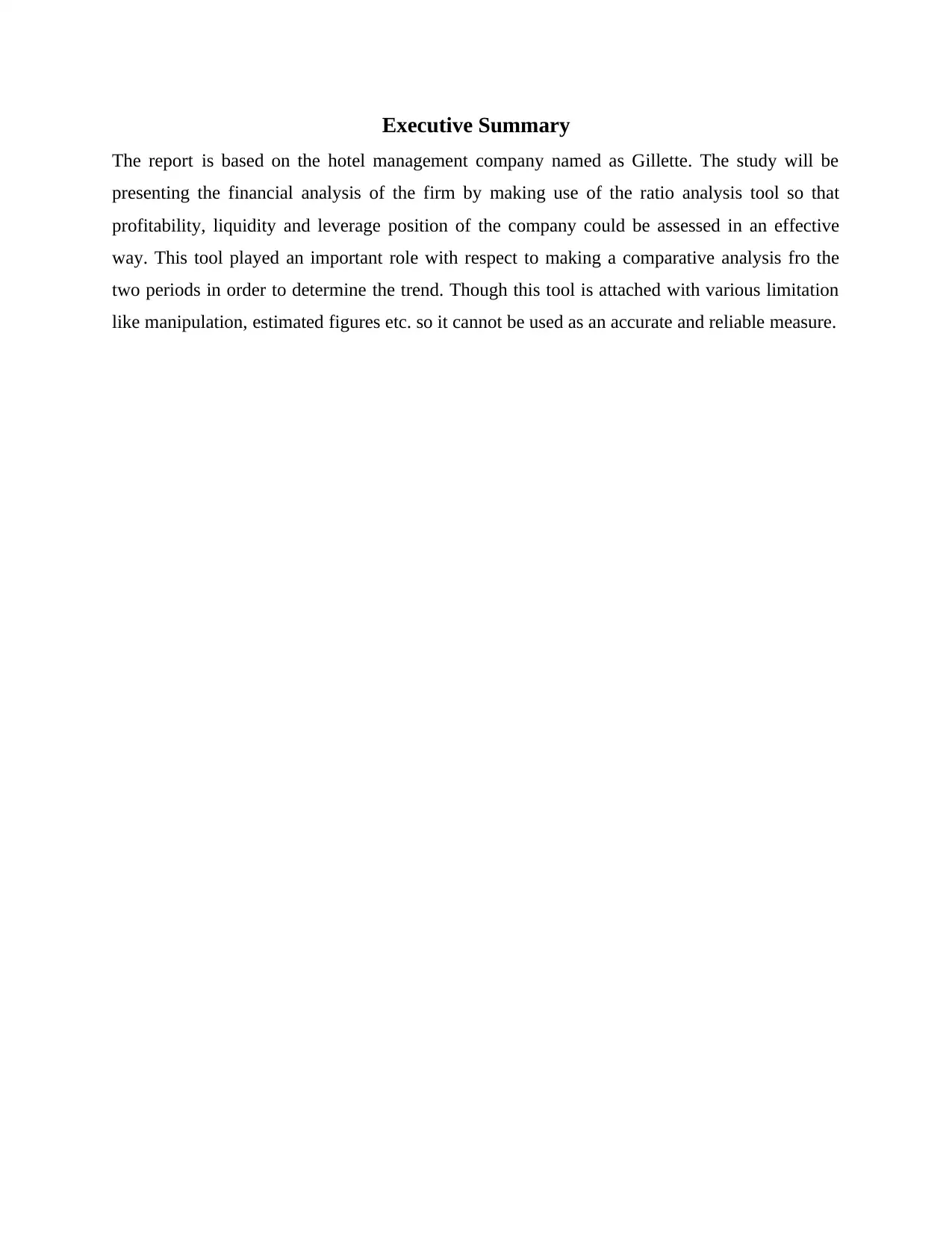
Executive Summary
The report is based on the hotel management company named as Gillette. The study will be
presenting the financial analysis of the firm by making use of the ratio analysis tool so that
profitability, liquidity and leverage position of the company could be assessed in an effective
way. This tool played an important role with respect to making a comparative analysis fro the
two periods in order to determine the trend. Though this tool is attached with various limitation
like manipulation, estimated figures etc. so it cannot be used as an accurate and reliable measure.
The report is based on the hotel management company named as Gillette. The study will be
presenting the financial analysis of the firm by making use of the ratio analysis tool so that
profitability, liquidity and leverage position of the company could be assessed in an effective
way. This tool played an important role with respect to making a comparative analysis fro the
two periods in order to determine the trend. Though this tool is attached with various limitation
like manipulation, estimated figures etc. so it cannot be used as an accurate and reliable measure.
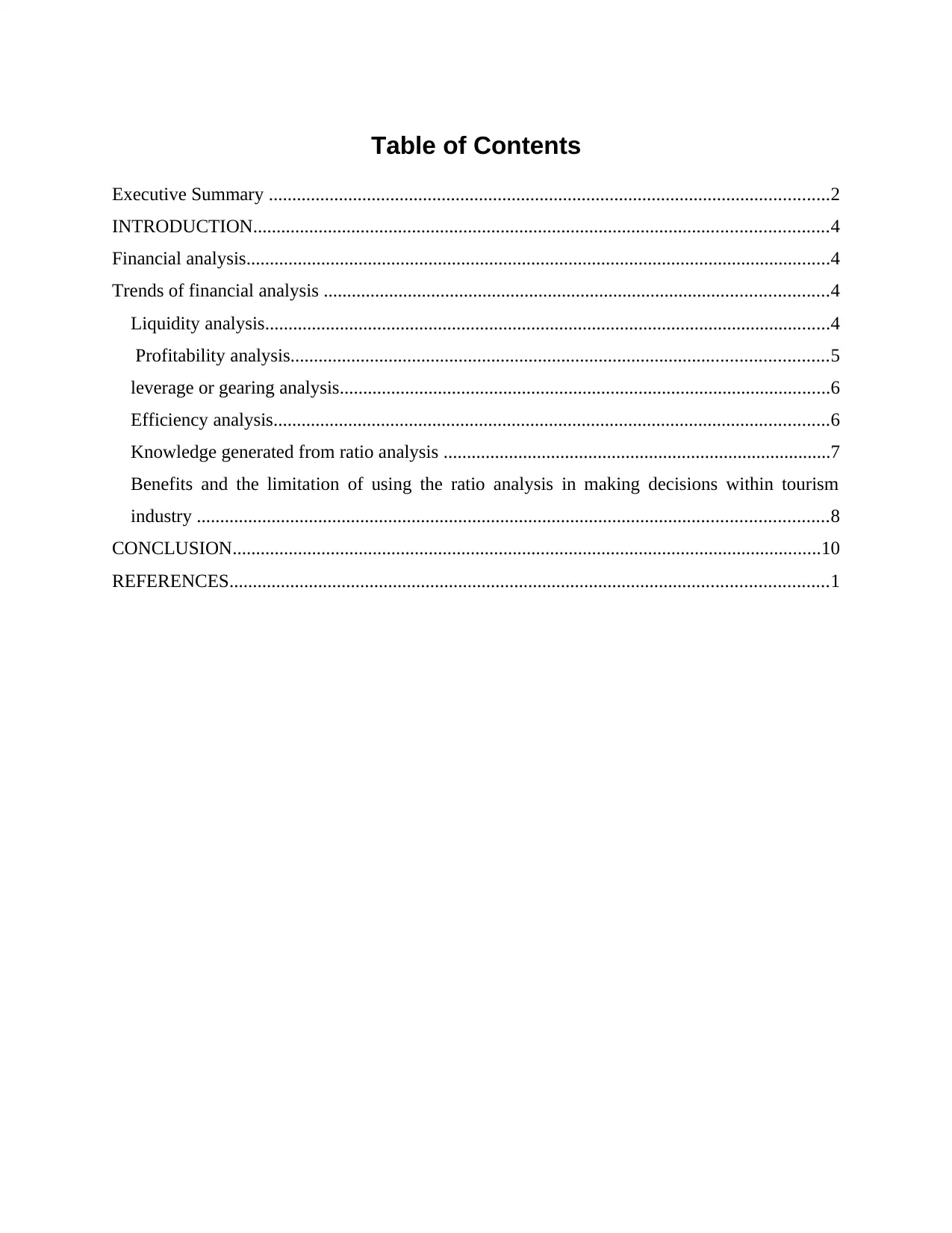
Table of Contents
Executive Summary ........................................................................................................................2
INTRODUCTION...........................................................................................................................4
Financial analysis.............................................................................................................................4
Trends of financial analysis ............................................................................................................4
Liquidity analysis.........................................................................................................................4
Profitability analysis...................................................................................................................5
leverage or gearing analysis.........................................................................................................6
Efficiency analysis.......................................................................................................................6
Knowledge generated from ratio analysis ...................................................................................7
Benefits and the limitation of using the ratio analysis in making decisions within tourism
industry .......................................................................................................................................8
CONCLUSION..............................................................................................................................10
REFERENCES................................................................................................................................1
Executive Summary ........................................................................................................................2
INTRODUCTION...........................................................................................................................4
Financial analysis.............................................................................................................................4
Trends of financial analysis ............................................................................................................4
Liquidity analysis.........................................................................................................................4
Profitability analysis...................................................................................................................5
leverage or gearing analysis.........................................................................................................6
Efficiency analysis.......................................................................................................................6
Knowledge generated from ratio analysis ...................................................................................7
Benefits and the limitation of using the ratio analysis in making decisions within tourism
industry .......................................................................................................................................8
CONCLUSION..............................................................................................................................10
REFERENCES................................................................................................................................1

INTRODUCTION
Financial statement analysis is a practice of assessing financial information of an entity
for the purpose of making appropriate decisions. External stakeholders uses it for understanding
an overall organizational health and in evaluating financial performance and value of the
business. The present report is based on Gillette Ltd which is seen as the hospitality company
that is involved in managing the portfolio of the hotels in the United Kingdom and the Northern
Ireland. Furthermore, the study highlights computation of the ratios for making financial
analysis and present liquidity, profitability and gearing position of the company. Moreover, the
report describes uses or importance of the ratio analysis and the benefits & limitations associated
with the ratio analysis tool.
Financial analysis
Trends of financial analysis
Liquidity analysis
It refers to the measurements that are used in examining an ability of an enterprise in
paying off its current obligations (Kahn and Baum, 2020). The major liquidity ratios includes
current and the quick ratio which depicts the liquidity position of the company in an overall
market or an industry.
Gillette
Liquidity ratio
Particulars Formula 2018 2019
Current assets 2325 2730
Current liabilities 990 752
Current ratio
Current
assets/Current
liabilities 2.35 3.63
Current assets 2325 2730
Inventory 700 900
Quick assets 1625 1830
Current liabilities 990 752
Quick ratio Quick assets/Current 1.64 2.43
Financial statement analysis is a practice of assessing financial information of an entity
for the purpose of making appropriate decisions. External stakeholders uses it for understanding
an overall organizational health and in evaluating financial performance and value of the
business. The present report is based on Gillette Ltd which is seen as the hospitality company
that is involved in managing the portfolio of the hotels in the United Kingdom and the Northern
Ireland. Furthermore, the study highlights computation of the ratios for making financial
analysis and present liquidity, profitability and gearing position of the company. Moreover, the
report describes uses or importance of the ratio analysis and the benefits & limitations associated
with the ratio analysis tool.
Financial analysis
Trends of financial analysis
Liquidity analysis
It refers to the measurements that are used in examining an ability of an enterprise in
paying off its current obligations (Kahn and Baum, 2020). The major liquidity ratios includes
current and the quick ratio which depicts the liquidity position of the company in an overall
market or an industry.
Gillette
Liquidity ratio
Particulars Formula 2018 2019
Current assets 2325 2730
Current liabilities 990 752
Current ratio
Current
assets/Current
liabilities 2.35 3.63
Current assets 2325 2730
Inventory 700 900
Quick assets 1625 1830
Current liabilities 990 752
Quick ratio Quick assets/Current 1.64 2.43
Secure Best Marks with AI Grader
Need help grading? Try our AI Grader for instant feedback on your assignments.
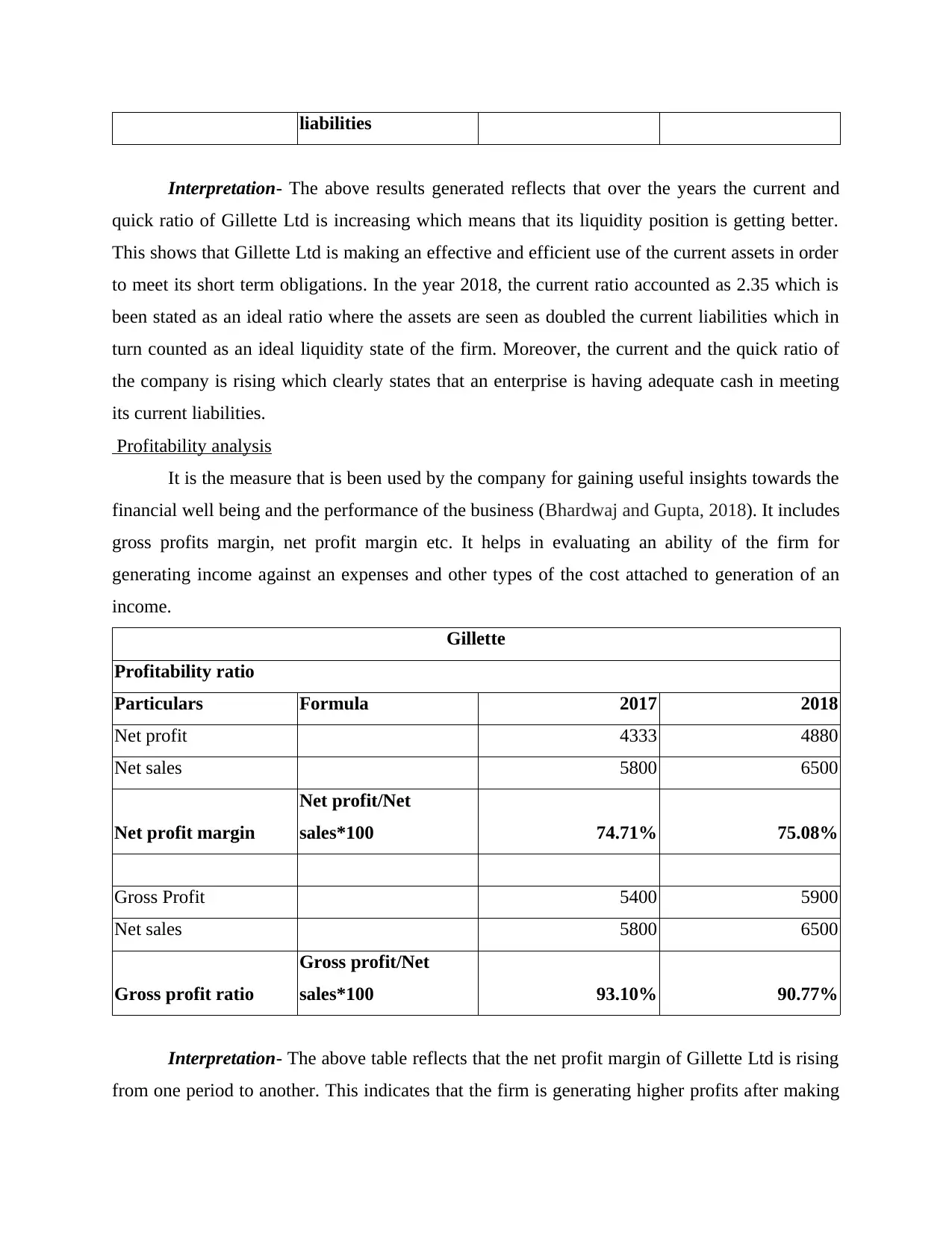
liabilities
Interpretation- The above results generated reflects that over the years the current and
quick ratio of Gillette Ltd is increasing which means that its liquidity position is getting better.
This shows that Gillette Ltd is making an effective and efficient use of the current assets in order
to meet its short term obligations. In the year 2018, the current ratio accounted as 2.35 which is
been stated as an ideal ratio where the assets are seen as doubled the current liabilities which in
turn counted as an ideal liquidity state of the firm. Moreover, the current and the quick ratio of
the company is rising which clearly states that an enterprise is having adequate cash in meeting
its current liabilities.
Profitability analysis
It is the measure that is been used by the company for gaining useful insights towards the
financial well being and the performance of the business (Bhardwaj and Gupta, 2018). It includes
gross profits margin, net profit margin etc. It helps in evaluating an ability of the firm for
generating income against an expenses and other types of the cost attached to generation of an
income.
Gillette
Profitability ratio
Particulars Formula 2017 2018
Net profit 4333 4880
Net sales 5800 6500
Net profit margin
Net profit/Net
sales*100 74.71% 75.08%
Gross Profit 5400 5900
Net sales 5800 6500
Gross profit ratio
Gross profit/Net
sales*100 93.10% 90.77%
Interpretation- The above table reflects that the net profit margin of Gillette Ltd is rising
from one period to another. This indicates that the firm is generating higher profits after making
Interpretation- The above results generated reflects that over the years the current and
quick ratio of Gillette Ltd is increasing which means that its liquidity position is getting better.
This shows that Gillette Ltd is making an effective and efficient use of the current assets in order
to meet its short term obligations. In the year 2018, the current ratio accounted as 2.35 which is
been stated as an ideal ratio where the assets are seen as doubled the current liabilities which in
turn counted as an ideal liquidity state of the firm. Moreover, the current and the quick ratio of
the company is rising which clearly states that an enterprise is having adequate cash in meeting
its current liabilities.
Profitability analysis
It is the measure that is been used by the company for gaining useful insights towards the
financial well being and the performance of the business (Bhardwaj and Gupta, 2018). It includes
gross profits margin, net profit margin etc. It helps in evaluating an ability of the firm for
generating income against an expenses and other types of the cost attached to generation of an
income.
Gillette
Profitability ratio
Particulars Formula 2017 2018
Net profit 4333 4880
Net sales 5800 6500
Net profit margin
Net profit/Net
sales*100 74.71% 75.08%
Gross Profit 5400 5900
Net sales 5800 6500
Gross profit ratio
Gross profit/Net
sales*100 93.10% 90.77%
Interpretation- The above table reflects that the net profit margin of Gillette Ltd is rising
from one period to another. This indicates that the firm is generating higher profits after making
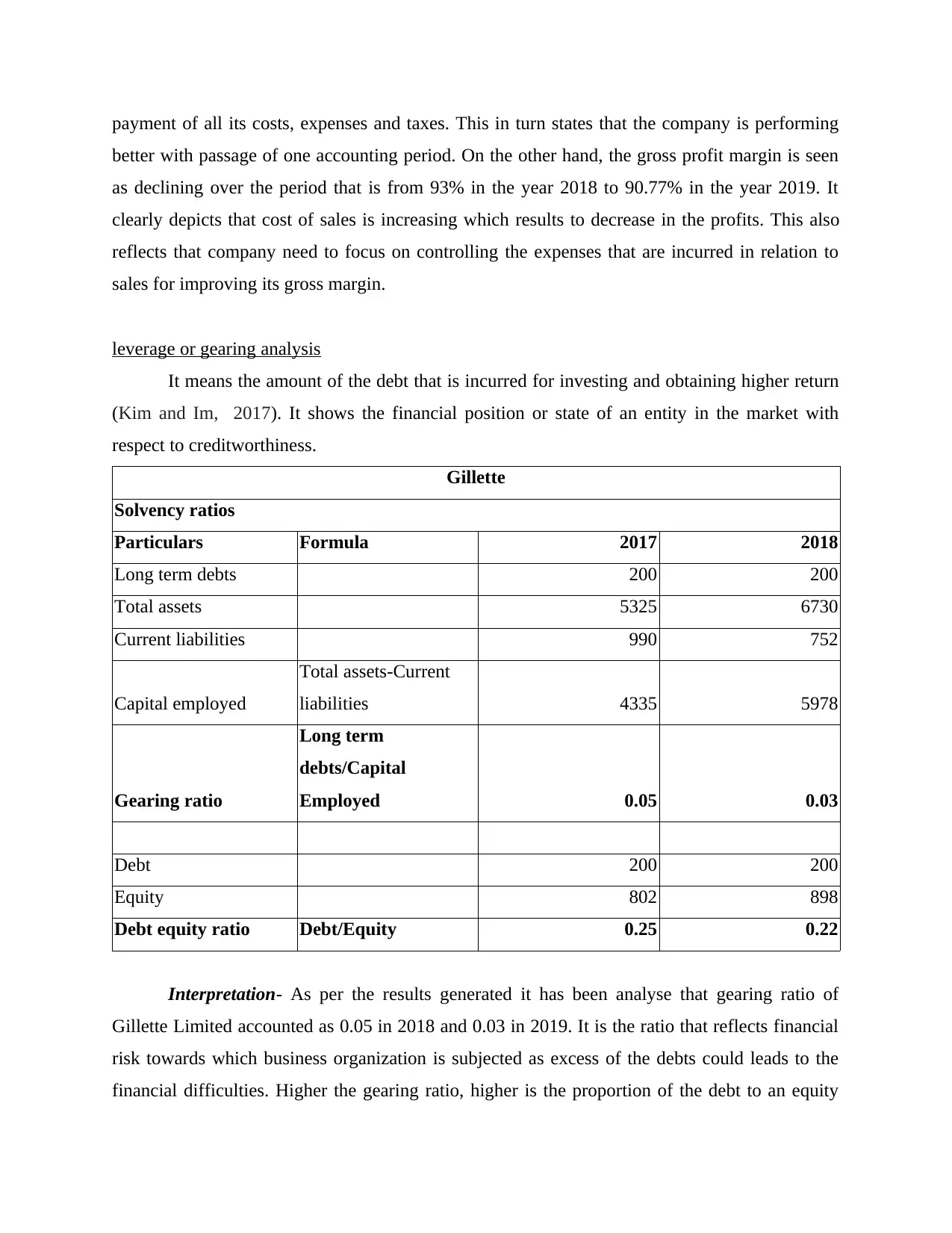
payment of all its costs, expenses and taxes. This in turn states that the company is performing
better with passage of one accounting period. On the other hand, the gross profit margin is seen
as declining over the period that is from 93% in the year 2018 to 90.77% in the year 2019. It
clearly depicts that cost of sales is increasing which results to decrease in the profits. This also
reflects that company need to focus on controlling the expenses that are incurred in relation to
sales for improving its gross margin.
leverage or gearing analysis
It means the amount of the debt that is incurred for investing and obtaining higher return
(Kim and Im, 2017). It shows the financial position or state of an entity in the market with
respect to creditworthiness.
Gillette
Solvency ratios
Particulars Formula 2017 2018
Long term debts 200 200
Total assets 5325 6730
Current liabilities 990 752
Capital employed
Total assets-Current
liabilities 4335 5978
Gearing ratio
Long term
debts/Capital
Employed 0.05 0.03
Debt 200 200
Equity 802 898
Debt equity ratio Debt/Equity 0.25 0.22
Interpretation- As per the results generated it has been analyse that gearing ratio of
Gillette Limited accounted as 0.05 in 2018 and 0.03 in 2019. It is the ratio that reflects financial
risk towards which business organization is subjected as excess of the debts could leads to the
financial difficulties. Higher the gearing ratio, higher is the proportion of the debt to an equity
better with passage of one accounting period. On the other hand, the gross profit margin is seen
as declining over the period that is from 93% in the year 2018 to 90.77% in the year 2019. It
clearly depicts that cost of sales is increasing which results to decrease in the profits. This also
reflects that company need to focus on controlling the expenses that are incurred in relation to
sales for improving its gross margin.
leverage or gearing analysis
It means the amount of the debt that is incurred for investing and obtaining higher return
(Kim and Im, 2017). It shows the financial position or state of an entity in the market with
respect to creditworthiness.
Gillette
Solvency ratios
Particulars Formula 2017 2018
Long term debts 200 200
Total assets 5325 6730
Current liabilities 990 752
Capital employed
Total assets-Current
liabilities 4335 5978
Gearing ratio
Long term
debts/Capital
Employed 0.05 0.03
Debt 200 200
Equity 802 898
Debt equity ratio Debt/Equity 0.25 0.22
Interpretation- As per the results generated it has been analyse that gearing ratio of
Gillette Limited accounted as 0.05 in 2018 and 0.03 in 2019. It is the ratio that reflects financial
risk towards which business organization is subjected as excess of the debts could leads to the
financial difficulties. Higher the gearing ratio, higher is the proportion of the debt to an equity
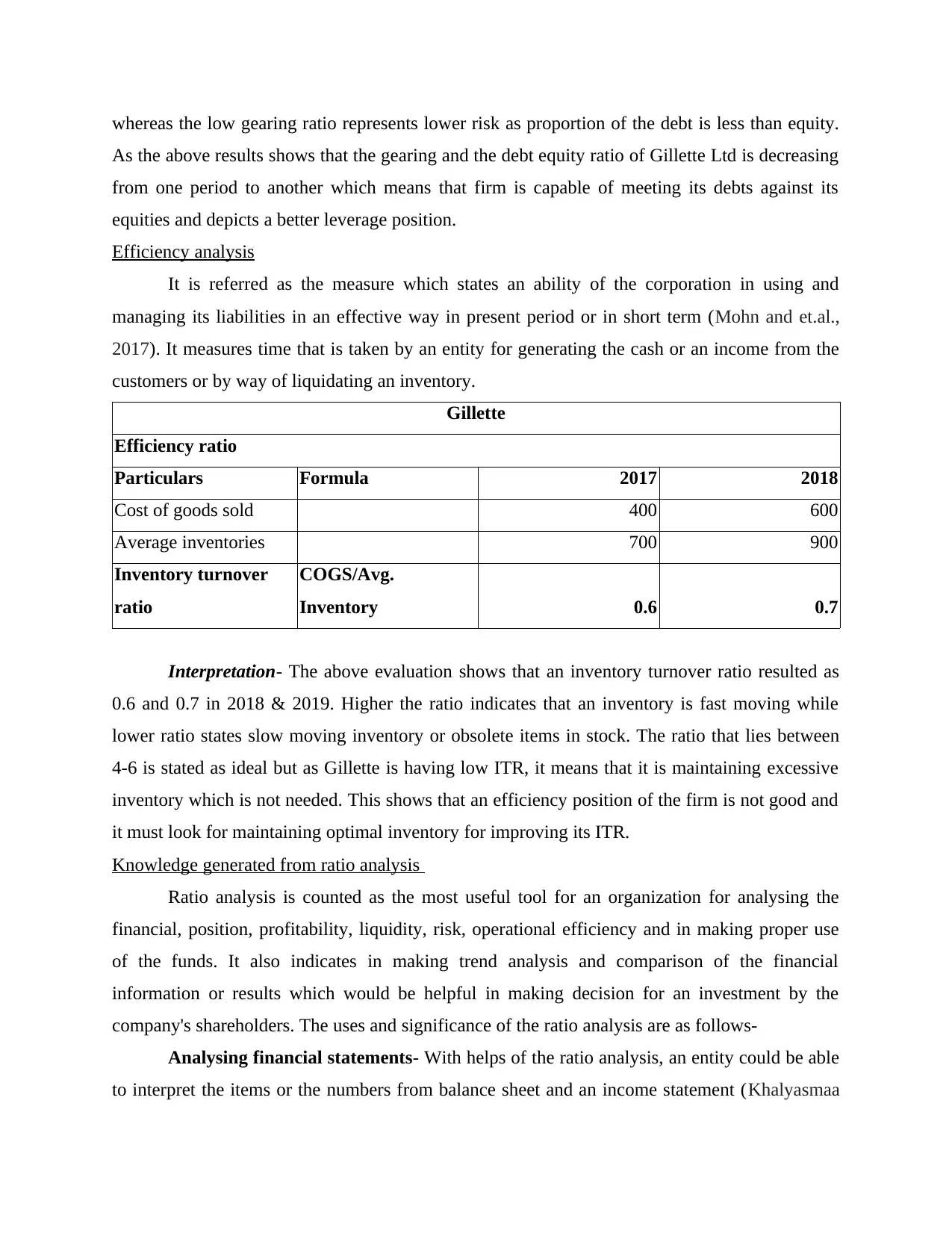
whereas the low gearing ratio represents lower risk as proportion of the debt is less than equity.
As the above results shows that the gearing and the debt equity ratio of Gillette Ltd is decreasing
from one period to another which means that firm is capable of meeting its debts against its
equities and depicts a better leverage position.
Efficiency analysis
It is referred as the measure which states an ability of the corporation in using and
managing its liabilities in an effective way in present period or in short term (Mohn and et.al.,
2017). It measures time that is taken by an entity for generating the cash or an income from the
customers or by way of liquidating an inventory.
Gillette
Efficiency ratio
Particulars Formula 2017 2018
Cost of goods sold 400 600
Average inventories 700 900
Inventory turnover
ratio
COGS/Avg.
Inventory 0.6 0.7
Interpretation- The above evaluation shows that an inventory turnover ratio resulted as
0.6 and 0.7 in 2018 & 2019. Higher the ratio indicates that an inventory is fast moving while
lower ratio states slow moving inventory or obsolete items in stock. The ratio that lies between
4-6 is stated as ideal but as Gillette is having low ITR, it means that it is maintaining excessive
inventory which is not needed. This shows that an efficiency position of the firm is not good and
it must look for maintaining optimal inventory for improving its ITR.
Knowledge generated from ratio analysis
Ratio analysis is counted as the most useful tool for an organization for analysing the
financial, position, profitability, liquidity, risk, operational efficiency and in making proper use
of the funds. It also indicates in making trend analysis and comparison of the financial
information or results which would be helpful in making decision for an investment by the
company's shareholders. The uses and significance of the ratio analysis are as follows-
Analysing financial statements- With helps of the ratio analysis, an entity could be able
to interpret the items or the numbers from balance sheet and an income statement (Khalyasmaa
As the above results shows that the gearing and the debt equity ratio of Gillette Ltd is decreasing
from one period to another which means that firm is capable of meeting its debts against its
equities and depicts a better leverage position.
Efficiency analysis
It is referred as the measure which states an ability of the corporation in using and
managing its liabilities in an effective way in present period or in short term (Mohn and et.al.,
2017). It measures time that is taken by an entity for generating the cash or an income from the
customers or by way of liquidating an inventory.
Gillette
Efficiency ratio
Particulars Formula 2017 2018
Cost of goods sold 400 600
Average inventories 700 900
Inventory turnover
ratio
COGS/Avg.
Inventory 0.6 0.7
Interpretation- The above evaluation shows that an inventory turnover ratio resulted as
0.6 and 0.7 in 2018 & 2019. Higher the ratio indicates that an inventory is fast moving while
lower ratio states slow moving inventory or obsolete items in stock. The ratio that lies between
4-6 is stated as ideal but as Gillette is having low ITR, it means that it is maintaining excessive
inventory which is not needed. This shows that an efficiency position of the firm is not good and
it must look for maintaining optimal inventory for improving its ITR.
Knowledge generated from ratio analysis
Ratio analysis is counted as the most useful tool for an organization for analysing the
financial, position, profitability, liquidity, risk, operational efficiency and in making proper use
of the funds. It also indicates in making trend analysis and comparison of the financial
information or results which would be helpful in making decision for an investment by the
company's shareholders. The uses and significance of the ratio analysis are as follows-
Analysing financial statements- With helps of the ratio analysis, an entity could be able
to interpret the items or the numbers from balance sheet and an income statement (Khalyasmaa
Paraphrase This Document
Need a fresh take? Get an instant paraphrase of this document with our AI Paraphraser
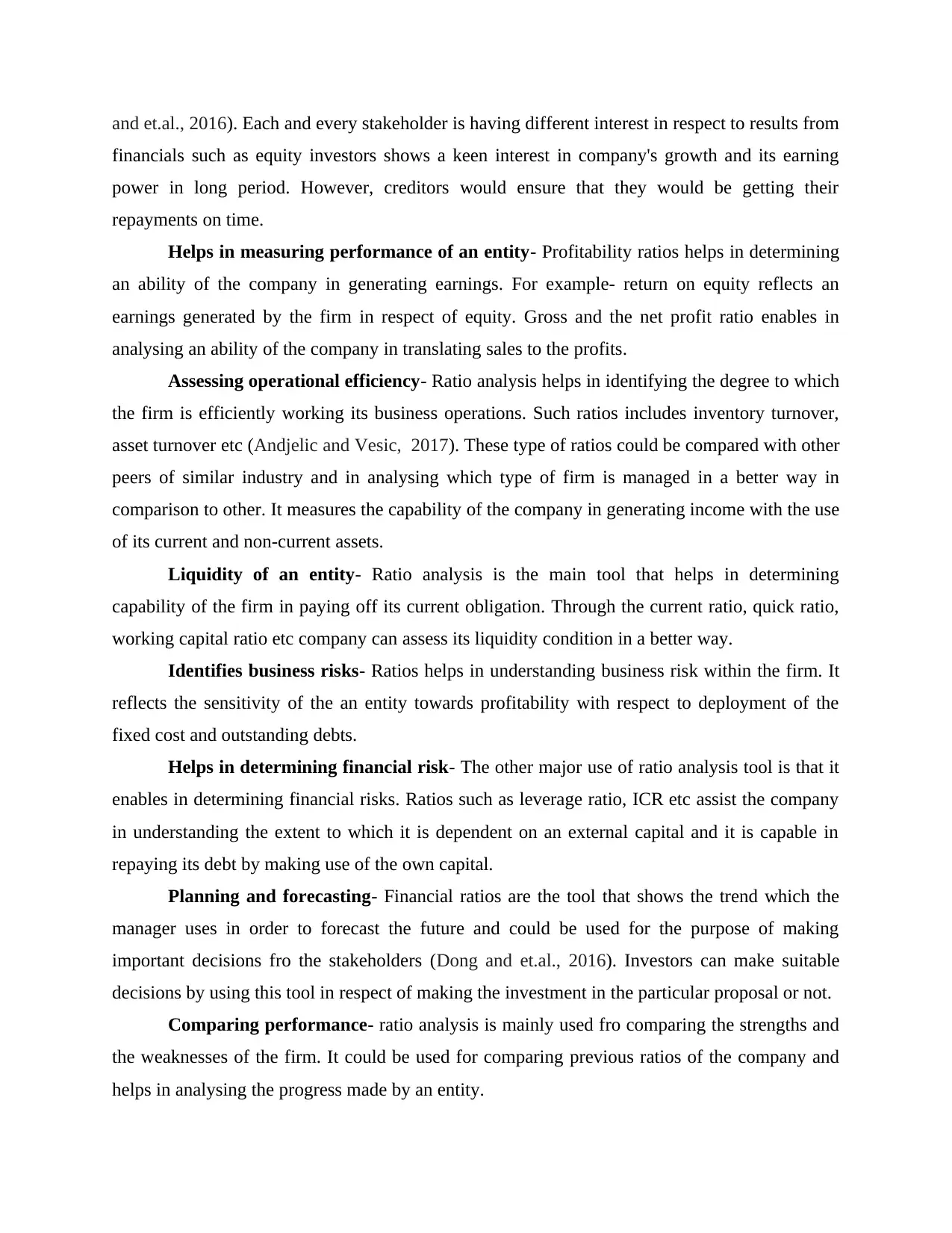
and et.al., 2016). Each and every stakeholder is having different interest in respect to results from
financials such as equity investors shows a keen interest in company's growth and its earning
power in long period. However, creditors would ensure that they would be getting their
repayments on time.
Helps in measuring performance of an entity- Profitability ratios helps in determining
an ability of the company in generating earnings. For example- return on equity reflects an
earnings generated by the firm in respect of equity. Gross and the net profit ratio enables in
analysing an ability of the company in translating sales to the profits.
Assessing operational efficiency- Ratio analysis helps in identifying the degree to which
the firm is efficiently working its business operations. Such ratios includes inventory turnover,
asset turnover etc (Andjelic and Vesic, 2017). These type of ratios could be compared with other
peers of similar industry and in analysing which type of firm is managed in a better way in
comparison to other. It measures the capability of the company in generating income with the use
of its current and non-current assets.
Liquidity of an entity- Ratio analysis is the main tool that helps in determining
capability of the firm in paying off its current obligation. Through the current ratio, quick ratio,
working capital ratio etc company can assess its liquidity condition in a better way.
Identifies business risks- Ratios helps in understanding business risk within the firm. It
reflects the sensitivity of the an entity towards profitability with respect to deployment of the
fixed cost and outstanding debts.
Helps in determining financial risk- The other major use of ratio analysis tool is that it
enables in determining financial risks. Ratios such as leverage ratio, ICR etc assist the company
in understanding the extent to which it is dependent on an external capital and it is capable in
repaying its debt by making use of the own capital.
Planning and forecasting- Financial ratios are the tool that shows the trend which the
manager uses in order to forecast the future and could be used for the purpose of making
important decisions fro the stakeholders (Dong and et.al., 2016). Investors can make suitable
decisions by using this tool in respect of making the investment in the particular proposal or not.
Comparing performance- ratio analysis is mainly used fro comparing the strengths and
the weaknesses of the firm. It could be used for comparing previous ratios of the company and
helps in analysing the progress made by an entity.
financials such as equity investors shows a keen interest in company's growth and its earning
power in long period. However, creditors would ensure that they would be getting their
repayments on time.
Helps in measuring performance of an entity- Profitability ratios helps in determining
an ability of the company in generating earnings. For example- return on equity reflects an
earnings generated by the firm in respect of equity. Gross and the net profit ratio enables in
analysing an ability of the company in translating sales to the profits.
Assessing operational efficiency- Ratio analysis helps in identifying the degree to which
the firm is efficiently working its business operations. Such ratios includes inventory turnover,
asset turnover etc (Andjelic and Vesic, 2017). These type of ratios could be compared with other
peers of similar industry and in analysing which type of firm is managed in a better way in
comparison to other. It measures the capability of the company in generating income with the use
of its current and non-current assets.
Liquidity of an entity- Ratio analysis is the main tool that helps in determining
capability of the firm in paying off its current obligation. Through the current ratio, quick ratio,
working capital ratio etc company can assess its liquidity condition in a better way.
Identifies business risks- Ratios helps in understanding business risk within the firm. It
reflects the sensitivity of the an entity towards profitability with respect to deployment of the
fixed cost and outstanding debts.
Helps in determining financial risk- The other major use of ratio analysis tool is that it
enables in determining financial risks. Ratios such as leverage ratio, ICR etc assist the company
in understanding the extent to which it is dependent on an external capital and it is capable in
repaying its debt by making use of the own capital.
Planning and forecasting- Financial ratios are the tool that shows the trend which the
manager uses in order to forecast the future and could be used for the purpose of making
important decisions fro the stakeholders (Dong and et.al., 2016). Investors can make suitable
decisions by using this tool in respect of making the investment in the particular proposal or not.
Comparing performance- ratio analysis is mainly used fro comparing the strengths and
the weaknesses of the firm. It could be used for comparing previous ratios of the company and
helps in analysing the progress made by an entity.
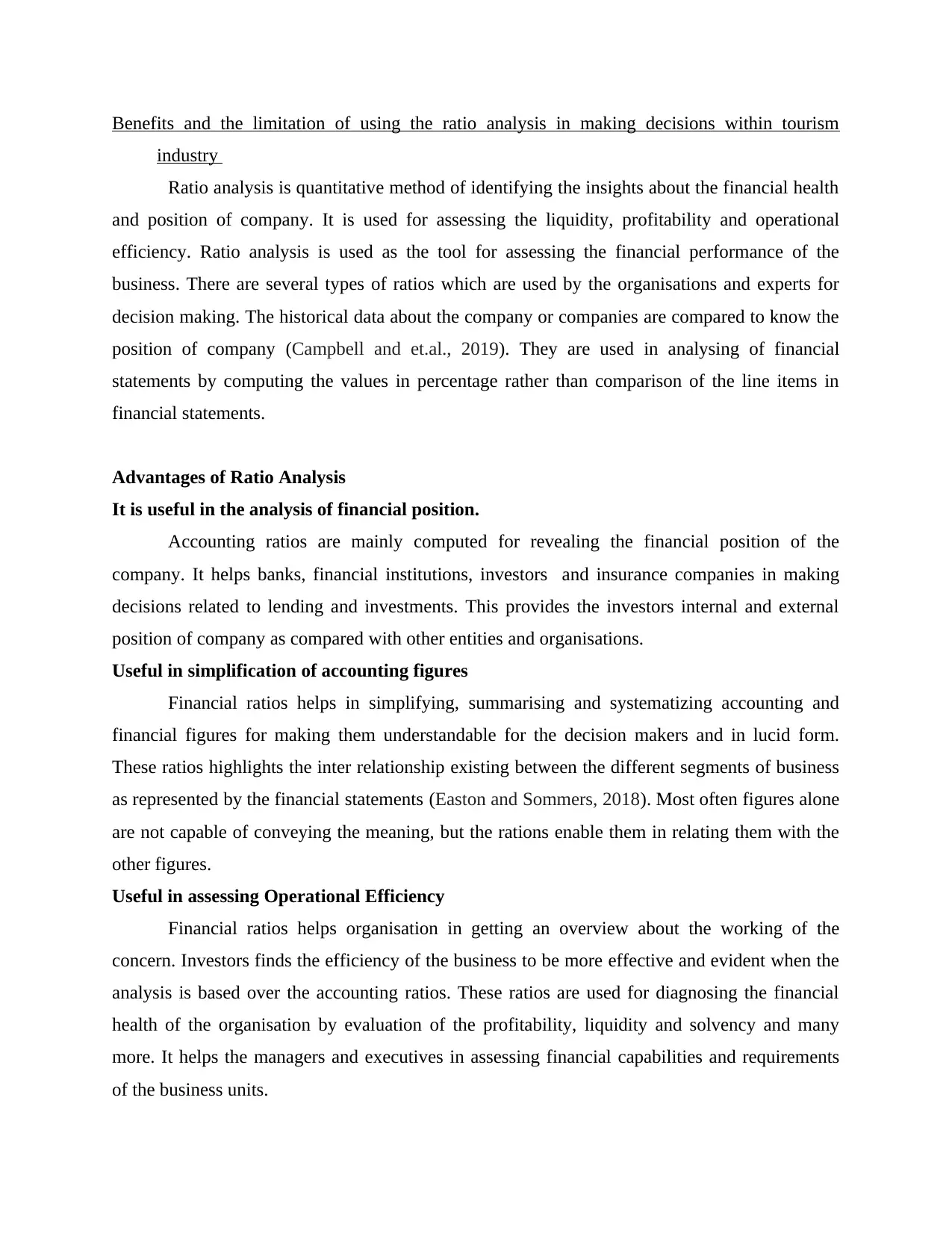
Benefits and the limitation of using the ratio analysis in making decisions within tourism
industry
Ratio analysis is quantitative method of identifying the insights about the financial health
and position of company. It is used for assessing the liquidity, profitability and operational
efficiency. Ratio analysis is used as the tool for assessing the financial performance of the
business. There are several types of ratios which are used by the organisations and experts for
decision making. The historical data about the company or companies are compared to know the
position of company (Campbell and et.al., 2019). They are used in analysing of financial
statements by computing the values in percentage rather than comparison of the line items in
financial statements.
Advantages of Ratio Analysis
It is useful in the analysis of financial position.
Accounting ratios are mainly computed for revealing the financial position of the
company. It helps banks, financial institutions, investors and insurance companies in making
decisions related to lending and investments. This provides the investors internal and external
position of company as compared with other entities and organisations.
Useful in simplification of accounting figures
Financial ratios helps in simplifying, summarising and systematizing accounting and
financial figures for making them understandable for the decision makers and in lucid form.
These ratios highlights the inter relationship existing between the different segments of business
as represented by the financial statements (Easton and Sommers, 2018). Most often figures alone
are not capable of conveying the meaning, but the rations enable them in relating them with the
other figures.
Useful in assessing Operational Efficiency
Financial ratios helps organisation in getting an overview about the working of the
concern. Investors finds the efficiency of the business to be more effective and evident when the
analysis is based over the accounting ratios. These ratios are used for diagnosing the financial
health of the organisation by evaluation of the profitability, liquidity and solvency and many
more. It helps the managers and executives in assessing financial capabilities and requirements
of the business units.
industry
Ratio analysis is quantitative method of identifying the insights about the financial health
and position of company. It is used for assessing the liquidity, profitability and operational
efficiency. Ratio analysis is used as the tool for assessing the financial performance of the
business. There are several types of ratios which are used by the organisations and experts for
decision making. The historical data about the company or companies are compared to know the
position of company (Campbell and et.al., 2019). They are used in analysing of financial
statements by computing the values in percentage rather than comparison of the line items in
financial statements.
Advantages of Ratio Analysis
It is useful in the analysis of financial position.
Accounting ratios are mainly computed for revealing the financial position of the
company. It helps banks, financial institutions, investors and insurance companies in making
decisions related to lending and investments. This provides the investors internal and external
position of company as compared with other entities and organisations.
Useful in simplification of accounting figures
Financial ratios helps in simplifying, summarising and systematizing accounting and
financial figures for making them understandable for the decision makers and in lucid form.
These ratios highlights the inter relationship existing between the different segments of business
as represented by the financial statements (Easton and Sommers, 2018). Most often figures alone
are not capable of conveying the meaning, but the rations enable them in relating them with the
other figures.
Useful in assessing Operational Efficiency
Financial ratios helps organisation in getting an overview about the working of the
concern. Investors finds the efficiency of the business to be more effective and evident when the
analysis is based over the accounting ratios. These ratios are used for diagnosing the financial
health of the organisation by evaluation of the profitability, liquidity and solvency and many
more. It helps the managers and executives in assessing financial capabilities and requirements
of the business units.
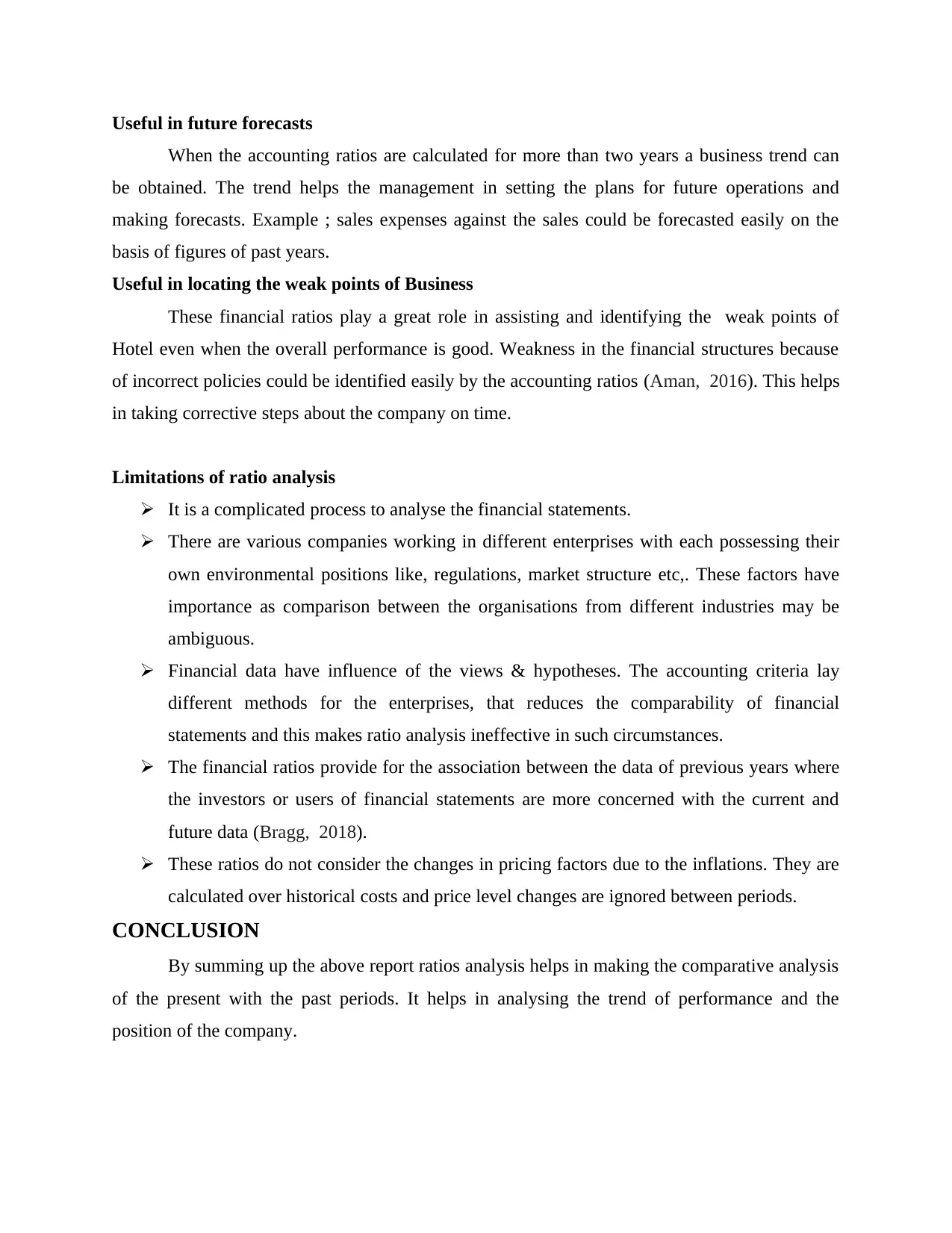
Useful in future forecasts
When the accounting ratios are calculated for more than two years a business trend can
be obtained. The trend helps the management in setting the plans for future operations and
making forecasts. Example ; sales expenses against the sales could be forecasted easily on the
basis of figures of past years.
Useful in locating the weak points of Business
These financial ratios play a great role in assisting and identifying the weak points of
Hotel even when the overall performance is good. Weakness in the financial structures because
of incorrect policies could be identified easily by the accounting ratios (Aman, 2016). This helps
in taking corrective steps about the company on time.
Limitations of ratio analysis
It is a complicated process to analyse the financial statements.
There are various companies working in different enterprises with each possessing their
own environmental positions like, regulations, market structure etc,. These factors have
importance as comparison between the organisations from different industries may be
ambiguous.
Financial data have influence of the views & hypotheses. The accounting criteria lay
different methods for the enterprises, that reduces the comparability of financial
statements and this makes ratio analysis ineffective in such circumstances.
The financial ratios provide for the association between the data of previous years where
the investors or users of financial statements are more concerned with the current and
future data (Bragg, 2018).
These ratios do not consider the changes in pricing factors due to the inflations. They are
calculated over historical costs and price level changes are ignored between periods.
CONCLUSION
By summing up the above report ratios analysis helps in making the comparative analysis
of the present with the past periods. It helps in analysing the trend of performance and the
position of the company.
When the accounting ratios are calculated for more than two years a business trend can
be obtained. The trend helps the management in setting the plans for future operations and
making forecasts. Example ; sales expenses against the sales could be forecasted easily on the
basis of figures of past years.
Useful in locating the weak points of Business
These financial ratios play a great role in assisting and identifying the weak points of
Hotel even when the overall performance is good. Weakness in the financial structures because
of incorrect policies could be identified easily by the accounting ratios (Aman, 2016). This helps
in taking corrective steps about the company on time.
Limitations of ratio analysis
It is a complicated process to analyse the financial statements.
There are various companies working in different enterprises with each possessing their
own environmental positions like, regulations, market structure etc,. These factors have
importance as comparison between the organisations from different industries may be
ambiguous.
Financial data have influence of the views & hypotheses. The accounting criteria lay
different methods for the enterprises, that reduces the comparability of financial
statements and this makes ratio analysis ineffective in such circumstances.
The financial ratios provide for the association between the data of previous years where
the investors or users of financial statements are more concerned with the current and
future data (Bragg, 2018).
These ratios do not consider the changes in pricing factors due to the inflations. They are
calculated over historical costs and price level changes are ignored between periods.
CONCLUSION
By summing up the above report ratios analysis helps in making the comparative analysis
of the present with the past periods. It helps in analysing the trend of performance and the
position of the company.
Secure Best Marks with AI Grader
Need help grading? Try our AI Grader for instant feedback on your assignments.
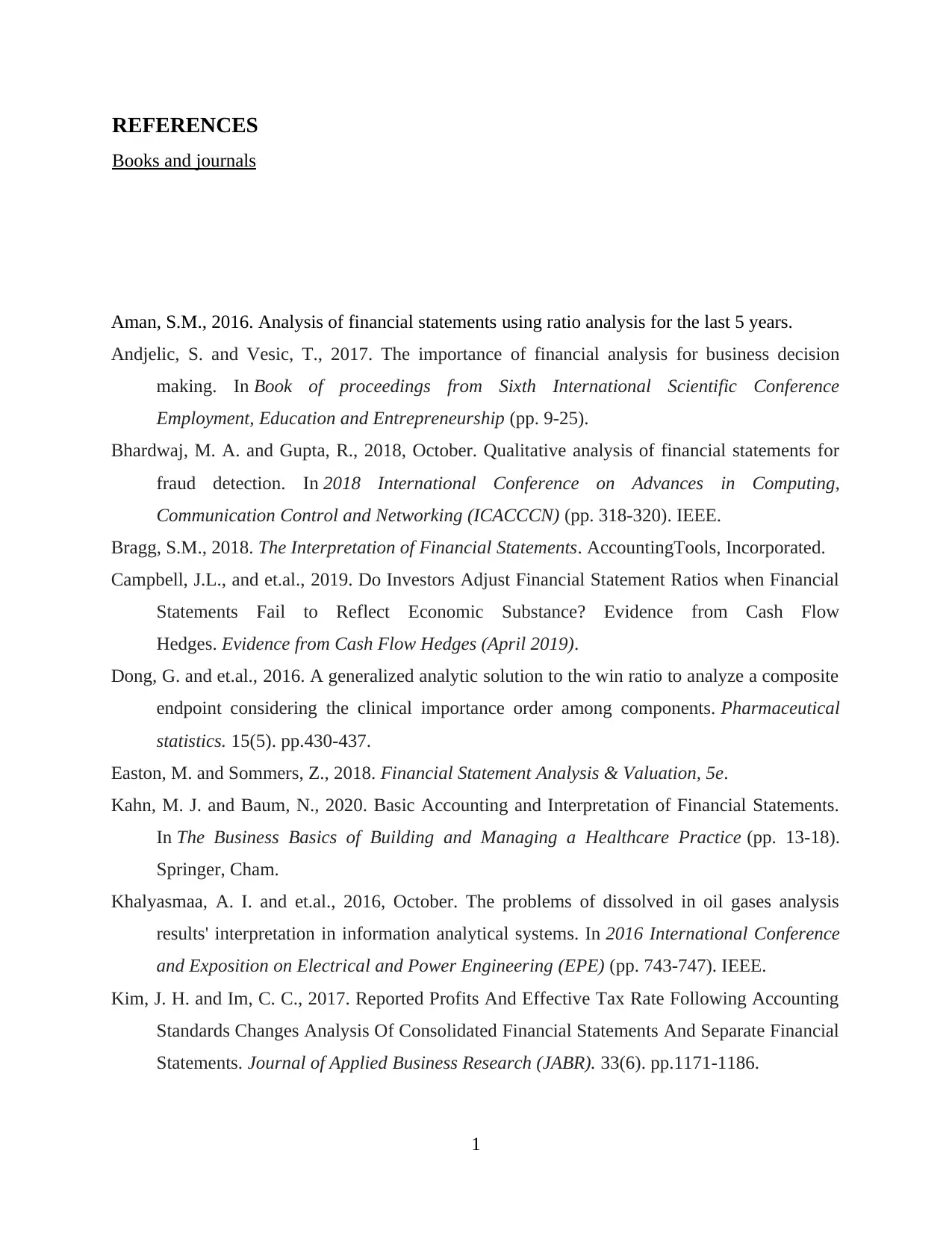
REFERENCES
Books and journals
Aman, S.M., 2016. Analysis of financial statements using ratio analysis for the last 5 years.
Andjelic, S. and Vesic, T., 2017. The importance of financial analysis for business decision
making. In Book of proceedings from Sixth International Scientific Conference
Employment, Education and Entrepreneurship (pp. 9-25).
Bhardwaj, M. A. and Gupta, R., 2018, October. Qualitative analysis of financial statements for
fraud detection. In 2018 International Conference on Advances in Computing,
Communication Control and Networking (ICACCCN) (pp. 318-320). IEEE.
Bragg, S.M., 2018. The Interpretation of Financial Statements. AccountingTools, Incorporated.
Campbell, J.L., and et.al., 2019. Do Investors Adjust Financial Statement Ratios when Financial
Statements Fail to Reflect Economic Substance? Evidence from Cash Flow
Hedges. Evidence from Cash Flow Hedges (April 2019).
Dong, G. and et.al., 2016. A generalized analytic solution to the win ratio to analyze a composite
endpoint considering the clinical importance order among components. Pharmaceutical
statistics. 15(5). pp.430-437.
Easton, M. and Sommers, Z., 2018. Financial Statement Analysis & Valuation, 5e.
Kahn, M. J. and Baum, N., 2020. Basic Accounting and Interpretation of Financial Statements.
In The Business Basics of Building and Managing a Healthcare Practice (pp. 13-18).
Springer, Cham.
Khalyasmaa, A. I. and et.al., 2016, October. The problems of dissolved in oil gases analysis
results' interpretation in information analytical systems. In 2016 International Conference
and Exposition on Electrical and Power Engineering (EPE) (pp. 743-747). IEEE.
Kim, J. H. and Im, C. C., 2017. Reported Profits And Effective Tax Rate Following Accounting
Standards Changes Analysis Of Consolidated Financial Statements And Separate Financial
Statements. Journal of Applied Business Research (JABR). 33(6). pp.1171-1186.
1
Books and journals
Aman, S.M., 2016. Analysis of financial statements using ratio analysis for the last 5 years.
Andjelic, S. and Vesic, T., 2017. The importance of financial analysis for business decision
making. In Book of proceedings from Sixth International Scientific Conference
Employment, Education and Entrepreneurship (pp. 9-25).
Bhardwaj, M. A. and Gupta, R., 2018, October. Qualitative analysis of financial statements for
fraud detection. In 2018 International Conference on Advances in Computing,
Communication Control and Networking (ICACCCN) (pp. 318-320). IEEE.
Bragg, S.M., 2018. The Interpretation of Financial Statements. AccountingTools, Incorporated.
Campbell, J.L., and et.al., 2019. Do Investors Adjust Financial Statement Ratios when Financial
Statements Fail to Reflect Economic Substance? Evidence from Cash Flow
Hedges. Evidence from Cash Flow Hedges (April 2019).
Dong, G. and et.al., 2016. A generalized analytic solution to the win ratio to analyze a composite
endpoint considering the clinical importance order among components. Pharmaceutical
statistics. 15(5). pp.430-437.
Easton, M. and Sommers, Z., 2018. Financial Statement Analysis & Valuation, 5e.
Kahn, M. J. and Baum, N., 2020. Basic Accounting and Interpretation of Financial Statements.
In The Business Basics of Building and Managing a Healthcare Practice (pp. 13-18).
Springer, Cham.
Khalyasmaa, A. I. and et.al., 2016, October. The problems of dissolved in oil gases analysis
results' interpretation in information analytical systems. In 2016 International Conference
and Exposition on Electrical and Power Engineering (EPE) (pp. 743-747). IEEE.
Kim, J. H. and Im, C. C., 2017. Reported Profits And Effective Tax Rate Following Accounting
Standards Changes Analysis Of Consolidated Financial Statements And Separate Financial
Statements. Journal of Applied Business Research (JABR). 33(6). pp.1171-1186.
1

Mohn, J. and et.al., 2017, April. Progress in the analysis and interpretation of N2O isotopes:
Potential and future challenges. In EGU General Assembly Conference Abstracts(Vol. 19,
p. 7034).
2
Potential and future challenges. In EGU General Assembly Conference Abstracts(Vol. 19,
p. 7034).
2
1 out of 12
Related Documents
Your All-in-One AI-Powered Toolkit for Academic Success.
+13062052269
info@desklib.com
Available 24*7 on WhatsApp / Email
![[object Object]](/_next/static/media/star-bottom.7253800d.svg)
Unlock your academic potential
© 2024 | Zucol Services PVT LTD | All rights reserved.





